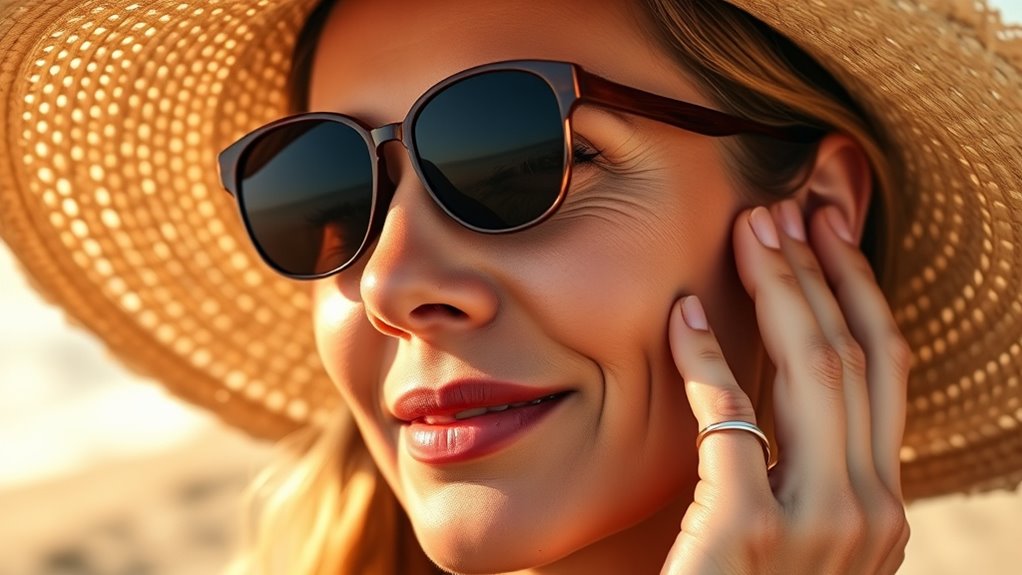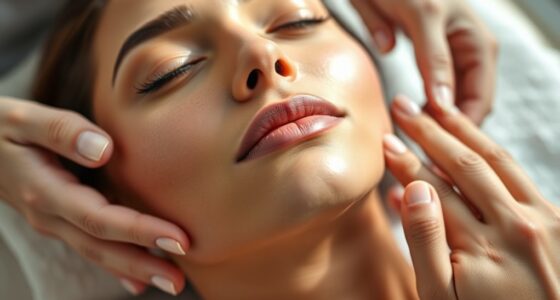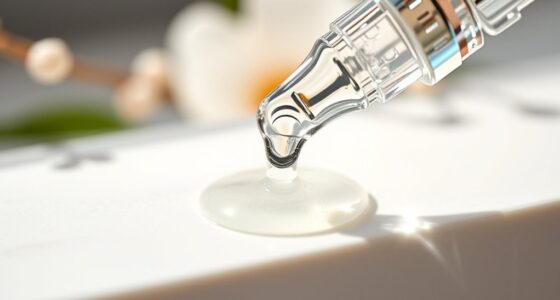To prevent photoaging, choose a broad-spectrum sunscreen with SPF 30 or higher, and apply it generously 15 minutes before sun exposure. Reapply every two hours, especially during swimming or sweating. Wear protective clothing, hats, and sunglasses, and seek shade during peak UV hours from 10 a.m. to 4 p.m. To keep your skin youthful, combine these strategies regularly—more tips on how to stay protected come up next.
Key Takeaways
- Use broad-spectrum SPF 30+ sunscreen and apply generously 15 minutes before sun exposure.
- Reapply sunscreen every two hours, especially during swimming or sweating.
- Seek shade during peak hours (10 a.m. to 4 p.m.) and wear protective clothing and accessories.
- Incorporate UPF clothing and UV-protective sunglasses for enhanced defense.
- Make sun safety a daily habit with consistent reapplication and additional protective measures.

Have you ever wondered if your sunscreen routine is enough to protect your skin? Ensuring proper UV protection is essential in preventing premature aging caused by sun damage. The key to effective sun safety isn’t just applying sunscreen once but establishing a comprehensive strategy that shields your skin from harmful ultraviolet rays. When it comes to photoaging, UV exposure is the primary culprit, leading to wrinkles, age spots, and loss of skin elasticity. That’s why understanding how to optimize your sunscreen routine is crucial for maintaining youthful, healthy skin over the years.
Proper UV protection through a comprehensive routine is essential to prevent photoaging and maintain youthful skin.
First, choose a broad-spectrum sunscreen that protects against both UVA and UVB rays. UVA rays penetrate deep into your skin, contributing to premature aging, while UVB rays primarily cause sunburn. By selecting a product with at least SPF 30 or higher, you increase your defense against these damaging rays. Remember, SPF labels indicate how long you can stay in the sun without burning compared to unprotected skin. However, SPF isn’t a license to stay outdoors indefinitely. Reapplication every two hours, or sooner if you’re swimming or sweating, is vital to maintain effective UV protection. Many people underestimate how quickly sunscreen wears off, especially during vigorous activities or in water.
Applying sunscreen properly makes a significant difference. Use enough to cover all exposed areas generously—most adults need about one ounce for full-body coverage. Don’t forget often-missed spots like your ears, the back of your neck, and the tops of your feet. It’s best to apply sunscreen 15 minutes before heading outside so it has time to bind to your skin. During peak sun hours—usually between 10 a.m. and 4 p.m.—sun safety becomes even more critical because UV rays are at their strongest. Seek shade whenever possible, wear protective clothing, and don a wide-brimmed hat and UV-protective sunglasses for added defense. Incorporating advanced filtration technologies in sun protection gear can further reduce UV exposure and skin damage.
Incorporating other sun safety habits enhances your overall protection. Staying in the shade during peak hours, avoiding tanning beds, and wearing UPF clothing can significantly reduce your UV exposure. Remember, UV rays can reflect off surfaces like water, sand, and concrete, increasing your risk even in seemingly shaded areas. By combining diligent sunscreen use with these sun safety practices, you actively combat photoaging and preserve your skin’s vitality. Consistency is key—making sun protection a daily habit will serve you well in maintaining youthful, radiant skin for years to come.
Frequently Asked Questions
Can Sunscreen Be Used on Sensitive or Allergy-Prone Skin?
Yes, you can use sunscreen on sensitive or allergy-prone skin. Look for hypoallergenic formulations that are designed to minimize ingredient sensitivities. Always check the ingredient list for potential irritants, and opt for mineral-based sunscreens with zinc oxide or titanium dioxide, as they’re gentler. Patch-test new products on a small skin area first to make certain they won’t cause reactions. This approach helps protect your skin without triggering allergies.
How Often Should I Reapply Sunscreen During Outdoor Activities?
You should reapply sunscreen every two hours during outdoor sun exposure to maintain protection. If you’re swimming, sweating heavily, or towel-drying, reapply more frequently, ideally immediately after these activities. Regular reapplication is essential because sunscreen wears off over time, especially with prolonged exposure. Staying vigilant about reapplication frequency helps prevent sun damage and photoaging, ensuring your skin remains protected throughout your outdoor activities.
Are Mineral or Chemical Sunscreens More Effective for Photoaging Prevention?
Think of mineral and chemical sunscreens as two knights guarding your skin. Mineral suns, with ingredients like zinc oxide and titanium dioxide, are often more effective for photoaging prevention because they create a physical barrier that reflects UV rays. Chemical suns absorb UV radiation but may be less stable over time. For maximum protection, choose a mineral sunscreen with proven ingredient efficacy, especially if you’re concerned about aging.
Does Sunscreen Expire, and How Can I Tell?
Sunscreen does expire, and you can tell by checking expiration indicators like a date on the bottle or tube. Proper sunscreen storage—away from heat, sunlight, and air exposure—helps maintain its effectiveness. If your sunscreen has a change in color, smell, or consistency, it’s best to replace it, even if the expiration date hasn’t passed. Using expired sunscreen reduces protection, increasing your risk of photoaging.
Can Makeup Products With SPF Replace Regular Sunscreen?
Sure, makeup with SPF might seem like a magic shield, but don’t rely on it solely. While it offers some protection, it often doesn’t provide the same broad-spectrum sunscreen efficacy as dedicated sunscreens, especially regarding coverage and reapplication. Think of makeup SPF as a charming sidekick, not the hero. For reliable protection, use a dedicated sunscreen underneath and apply makeup with SPF as an extra layer.
Conclusion
By following these sunscreen strategies, you’re taking the bull by the horns and protecting your skin from premature aging. Remember, consistency is key—applying sunscreen daily keeps your skin looking youthful and vibrant. Think of it as planting seeds for a healthier future; the effort you put in today will pay off tomorrow. Don’t wait for trouble to knock—stay proactive, stay protected, and keep your skin shining bright for years to come.









